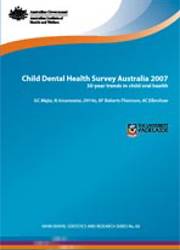Summary
This report describes the state of oral health of Australian children examined by school dental service (SDS) staff in 2007. It also describes trends in oral health of Australian children between 1989 and 2007. The most recent findings are drawn from the 2007 Child Dental Health Survey (CDHS) which analysed the data of 110,014 children aged 4 to 15 from most states and territories. The longer term trends highlight results for children aged 6 and 12 as these are the standard age groups for reporting on dental caries experience in the deciduous and permanent teeth respectively. Due to missing data from Victoria, any comparisons with previous years or international statistics should be made with caution. The figures presented over 30 years are drawn from previous CDHSs and monitoring undertaken by the (then) Commonwealth Department of Health.
Oral health status of Australian children
Just under half (46%) of children aged 6 attending school dental services had a history of decay in their deciduous (‘baby’) teeth—that is, one or more decayed, missing or filled deciduous teeth (dmft). On average, children aged 6 had almost two dmft per child (dmft = 1.95). The one-tenth of children aged 6 with the most extensive history of deciduous tooth decay had almost 10 deciduous teeth affected, which was over 5 times the national average.
Thirty-nine per cent of children aged 12 and 60% of children aged 15 had some history of decay in their permanent teeth—that is, one or more decayed, missing and filled permanent teeth. On average children aged 12 had just less than one affected tooth (DMFT = 0.95), while children aged 15 had just over two (DMFT = 2.10) decayed, missing and filled permanent teeth. The one-tenth of children aged 12 to 15 with the most extensive history of permanent tooth decay had between 5.21 and 8.60 permanent teeth affected, which was more than 4 times the national average of decayed, missing and filled teeth for children of those ages.
Between 1977 and the mid-1990s, the average number of deciduous teeth affected by caries halved in children aged 6, but increased from the late 1990s. Caries in permanent teeth of children aged 12 has declined even more dramatically. In 1993, children aged 12 had less than one-quarter the number of teeth affected by caries than in 1977. However, this number has increased slightly since 1993.
Caries experience varied between states and territories and over time. However, the differences should be treated with caution as they may be the result of different coverage policies, variations in targeting practices (e.g. high-risk groups), and varying levels of access to service among different states and territories.
Conclusions
A minority of Australian children experienced high levels of dental caries.
Caries has declined markedly in the permanent teeth of children aged 12, but declined far less in the deciduous teeth of children aged 6.
Preliminary material: Acknowledgments; Abbreviations; Places; Symbols
1 Introduction
What is dental decay (caries)?
Classifying the extent of decay
Risk factors for dental decay
Dental decay prevention
Measuring dental decay
Data used in this report
2 The dental health of Australia’s children
Children’s dental health
Dental decay by state and territory
Fissure sealants
3 Trends
National
States and territories
Appendix: Description of survey method
End matter: References; List of tables; List of figures



